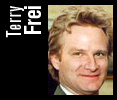 | |
 |

|
| Tuesday, October 1 Updated: October 2, 5:40 PM ET Great defensemen found in the mix By Terry Frei Special to ESPN.com |
||||||||||||||||||||
|
With his hair flying and conventional standards left behind in his wake, Bobby Orr's revolutionary talents changed the perceived possibilities for the men who play his position.
Don't we tend to categorize defensemen, as if this was in the tradition of dividing them into left- and right-handed shots? Sandis Ozolinsh? Sergei Zubov? Brian Rafalski? Sergei Gonchar? Phil Housley? Al MacInnis? Darryl Sydor? Offensive defensemen. Scott Stevens? Derian Hatcher? Adam Foote? Defensive defensemen. "The guys who overlap are your true stars," says Kings general manager Dave Taylor. He cites two of the obvious examples, but only as a starting point: Detroit's Nicklas Lidstrom and Colorado's Rob Blake. Blake delivers the thunderous hits and hip checks to go with his offensive skills. Lidstrom plays with more aggressiveness than he is given credit for, but also an uncanny economy and efficiency of movement that emphasize his intelligence on the ice. And all that comes with a see-the-ice-in-slow-motion offensive sense of a savvy center. "Lidstrom might not have the same physical attributes or the punishing checks, like Blake has, but positionally he's very strong," Taylor says. "He's strong on the penalty kill and moves the puck and can quarterback the power play. "But those guys are really rare. There are a few of them in the league, but they don't come along very often." Chris Pronger and Brian Leetch (although some still think of him as locked into the "offensive" category) deserve to be tossed into that category. Ed Jovanovski is getting there. Chris Chelios, adaptive to the circumstances of his team and smart enough to make allowances for his age, has been a hybrid to varying degrees over his career. (His most amazing attribute, though, might be his ability to play much "bigger" than he really is.)
"We look for mobility in our defenseman now, the way the game is played. We like to play up-tempo style, particularly in the Western Conference. If you have a defenseman who can skate and move the puck, it fits into the play pretty well." Sometimes that doesn't show up in numbers, not even in plus-minus. The elite are the men who can be crucial, even indispensable on either special team. They're the guys you HAVE to have out there when on the short end of a 5-on-3 (if they're not in the box themselves), but also on the point of the power play. In today's game, some degree of "hybrid" play is coveted more than ever. Even when Vladimir Konstantinov was wreaking havoc for the Wings, he could efficiently get involved at the offensive end, especially as part of the five-man Russian unit. The menacing, threatening defenders of this era nonetheless seem one-dimensional if they can't significantly pitch in at the other end. "Particularly with the way they're going to call interference, the holdup and the obstruction, I think you have to have somebody who skates really well and can move the puck," says Lightning general manager Jay Feaster. "It's one of the things we've struggled with here. We need more mobility and puck-handling ability out of our 'D.' You have to be able to skate well and you have to be able to make that first pass because otherwise, you're just pinned in your own zone. It's a long night. "And you can't be a guy who can move the puck but be such a defensive liability that the coach can't put you out there. But at the same time, if you're this great stay-at-home defenseman and you don't have any mobility and can't move, that makes for a long night, too. The guys who are the great ones who are hybrids. They're the ones who are responsible defensively and can play great defensive hockey, but have the ability to skate it out on their own and make that great first pass." Hurricanes GM Jim Rutherford says, "You still have different types of defensemen, but I believe the emphasis has changed as to the style. Having mobility is definitely very important." He adds that "with the way the game is going with the changing standards for obstruction, teams with the ability to move the puck will really have an advantage." There are solid, praiseworthy players making the most of what they have, staying home and tending to business on the blue line. Every team has them. Champions require them. But the great defenseman are those who can do it all -- or at least close to it. Lidstrom has shown that the lack of that classic, sneering, Larry Robinson-mean streak doesn't have to mean softness. (Robinson also was a lot more capable offensively than usually acknowledged. He was an effective complementary element in that Canadiens' attack.) But the more conventional hybrid defenseman, such as Blake and (earlier) Ray Bourque, are perfectly capable of being as dirty -- OK, make that rugged -- as they need to be. Actually, they can be anything they want to be. Terry Frei is a regular contributor to ESPN.com. His book, "Horns, Hogs, and Nixon Coming," will be published by Simon and Schuster in December. It can be pre-ordered at Amazon.com or BarnesandNoble.com. |
| |||||||||||||||||||
